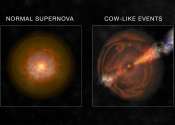Fossil shows evidence of gymnosperm pollination of alienopteridae
Alienopteridae were originally proposed as a new insect order (Alienoptera) in 2016. At first, they were only found in mid-Cretaceous Burmese amber, but later specimens were also reported from Brazil and the U.S.









